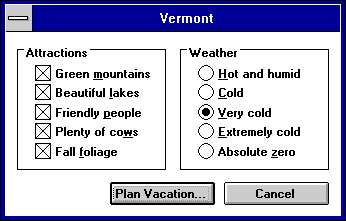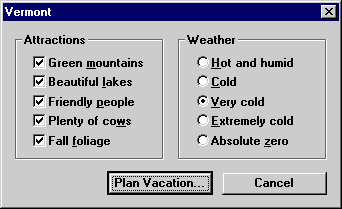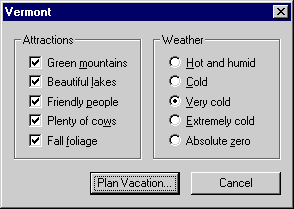A Case Study: The Borland Custom Controls
In the bad old days of Windows 3.1 programming, dialog boxes used to look like this:

Then, in 1991, Borland International released their custom controls, which allowed you to create dialog boxes like this:

These 3-D controls were a significant improvement over the old, boring 2-D controls that were part of Windows. Without these controls, only command button controls had a 3-D appearance. With these controls, almost all controls could have a 3-D appearance and dialog boxes could have a sculptured, chiseled-steel look. All of a sudden everyone, myself included, was developing programs using these controls.
I have regretted it ever since. When I finally came to my senses, I removed them from the programs I was working on. Now I am embarrassed to show programs I developed back then because they used these controls.
Why? While 3-D controls are certainly an improvement over the 2-D controls, these controls were way too much. Too much "in your face"—having too much texture, too much 3-D, and too much color—they soon became irritating. Using them resulted in sensory overload and often drew attention to interface elements that really shouldn't receive attention. And their awkward fixed size made efficient screen layout especially difficult. What was I thinking? What was everyone else thinking? My only defense is that it seemed like a good idea at the time.
To put us back on the right track, Microsoft released the Ctl3d.dll and later the Ctl3dv2.dll control libraries. These controls allowed programmers to use 3-D controls without overdoing it to create dialog boxes like this one:

While certainly a step in the right direction, these controls can still be improved. Let's compare all these dialog boxes to one using the Win32 controls:

Isn't this dialog box much better? Using normal text instead of bold text creates a much cleaner and crisper look. The command buttons, check boxes, and radio buttons use very simple 3-D graphics. Note that the framing rectangle around the dialog box and command buttons isn't even black all the way around—it's black on the lower and right sides only. The use of black is minimized to give the controls a softer appearance. In short, these controls use the simplest graphics possible to convey an elegant 3-D appearance.
EAN: 2147483647
Pages: 334